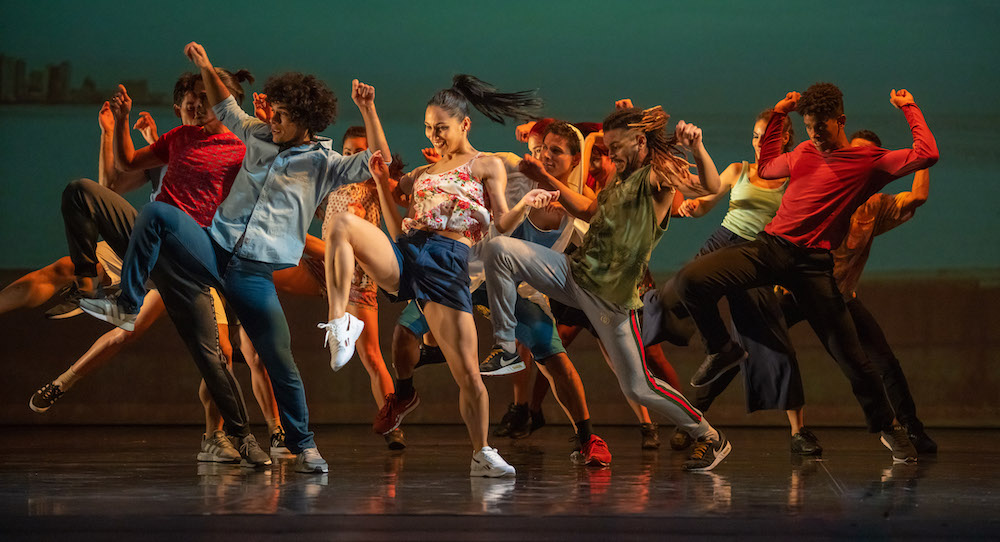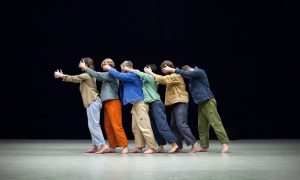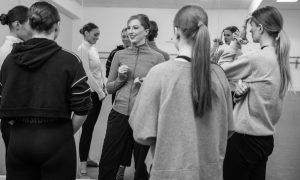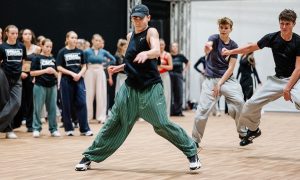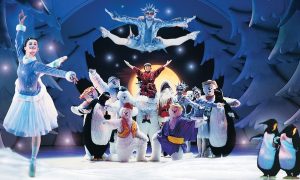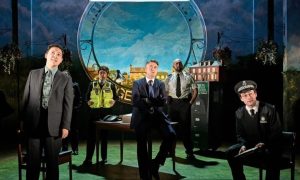Sadler’s Wells, London.
24 September 2025.
Carlos Acosta founded Acosta Danza to develop young dance talent emerging from Cuba, and combines classical and contemporary, aiming to capture Cuba’s unique ‘fusion of cultures, rhythms and dances.’ We are ready at this celebration evening tonight, to mark the 10th anniversary of Acosta Danza, to watch the work of four choreographers in A Decade in Motion, including two UK premieres: 98 Días and Llamada.
The curtain opened on the skeleton of a huge cube, which was solely lit. We could see other dancers waiting in the shadows of the stage surrounding it. Four dancers entered the cube one at time and began to move expansively within the space in silence, a great deal of expectation in the air.
La Ecuaciόn, energetically choreographed by George Céspedes with music by X Alfonzo, presented the four dancers, two on either side of the cube in the shadows. They jumped into it together as the music, described as a ‘chugging techno beat’, exploded into life. They moved as a four, in partners and alone, entwined yet each bringing their own personal style into the spotlight. Stirring dynamic use of the floor, patterns and intricate engagement between the dancers in close proximity, in the tight space within the cube’s perimeters.
It was a strong and enjoyable opening, dampened rather by the lengthy curtain down in between each number — understandably to prepare the stage for the next number, but effective in halting continuity and flow of the production.
The second number was 98 Días, choreographed by Javier de Frutos, who also designed the blue overall-style costumes for the 10 dancers. An unusual number, which seemed at odds with the pre-performance writeup describing it as a vibrant work about falling in love with a place far from home, in which Spanish playwright Federico Garcia Lorca found himself so enchanted by Cuba that a short visit turned into the happiest 98 days of his life. A large white square was taped out on the stage floor and dancers sat on chairs across the back, the dancer portraying Lorca central. The Spanish poetry was spoken aloud and used as a soundtrack as he began to move. This was satisfying to watch as he followed the inflections, tones and flow of the language, including breaths and pauses. I’d like to have felt his enchantment of Cuba, but the uniformed movement, costume and bleak stage set up either did not, or did not help to convey this, even though the dancing itself was often impassioned.
Act 2 opened with Goyo Montero’s Llamada — the title chosen as a description of ‘something that arises within us. We cannot help but follow it.’ Llamada promised to explore an interesting mix of sexuality, rage and faith and began with soloists dressed in white, appearing in their own spotlight in turn, until all nine dancers were lit. Percussive rhythms built, and a low suspended chord hummed in the background. Emotion was evident on stage from the outset, the nine dancers each picking out different elements in the music to follow. The spots disappeared and dancers moved into a section of unison, in their white and beige costumes. Male dancers were bare-chested and females in neutral tops. Some wore trousers, and three men white skirts. Red lighting was used effectively in this piece, particularly in description of emotion when two men first kissed in a spotlight, before one of them was pushed away and verbally abused by the others in a tight pack. Quite the statement when the victim himself joined the shunning crowd and the shouting.
Our final number tonight brought the whole company together to perform De Punta a Cabo, by Cuban contemporary choreographer Alexis Fernández. A fabulous opening scene; a projected film of the dancers walking along the esplanade, the blue sea and sky ahead of them, as dancers themselves made their way casually onto the stage. It offered the feeling of a relaxed chilled evening gathering of friends.
Tonight’s evening was filled with fresh and innovative dance, but again expectation was slightly mis-matched with reality in this last piece. Warm action shots of dancers in individual street wear and trainers and programme depiction of ‘all the hallmarks of Cuban culture set against the Malecόn esplanade in Havana’ encouraged an idea of a foot-tapping, party-style number. There were moments of this, the introduction of three female dancers on pointe, partnered by men in trainers being a standout moment. Plenty of fun and effective enmeshing of individualities and styles. Impressive aerial work and fast and complex partnering. Even the music was a fascinating mix of classical with Cuban. Two large bongo drums were brought onto stage, and there was a catchy salsa dance.
The mood mellowed, music slowed and as is currently frequently seen in productions, dancers sensually removed outer clothing down to their nude foundation garments. The movement among their close group was continuously swirling, bringing the whole piece to possibly an anti-climatic end, with dancers melting to the ground and their projected counterparts returning to the screen to pose together on the esplanade.
There were lively bows with a salsa feel and disco lights.
By Louise Ryrie of Dance Informa.


